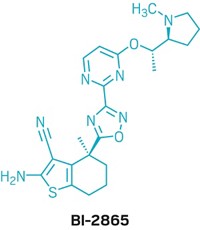Advertisement
Grab your lab coat. Let's get started
Welcome!
Welcome!
Create an account below to get 6 C&EN articles per month, receive newsletters and more - all free.
It seems this is your first time logging in online. Please enter the following information to continue.
As an ACS member you automatically get access to this site. All we need is few more details to create your reading experience.
Not you? Sign in with a different account.
Not you? Sign in with a different account.
ERROR 1
ERROR 1
ERROR 2
ERROR 2
ERROR 2
ERROR 2
ERROR 2
Password and Confirm password must match.
If you have an ACS member number, please enter it here so we can link this account to your membership. (optional)
ERROR 2
ACS values your privacy. By submitting your information, you are gaining access to C&EN and subscribing to our weekly newsletter. We use the information you provide to make your reading experience better, and we will never sell your data to third party members.
Pharmaceuticals
Troublemaking HER3 Enzyme Trashed
Drug Discovery: Cancer-causing pseudokinase directed to cellular garbage can
by Stu Borman
October 23, 2014
| A version of this story appeared in
Volume 92, Issue 43

A new study shows how pseudokinases, signaling enzymes that cause cancers and blood diseases, can be inhibited effectively by small molecules, a feat many researchers in the field believed wasn’t possible. The work could lead to pseudokinase-targeted drugs that fight cancer and other conditions.
Forty-eight pseudokinases account for 9% of the 520 kinases found in humans, notes Nathanael S. Gray of Dana-Farber Cancer Institute, in Boston, who carried out the study with Dana-Farber colleague Pasi A Jänne, Craig M. Crews of Yale University, and coworkers (Nat. Chem. Biol. 2014, DOI: 10.1038/nchembio.1658).
The team focused on the pseudokinase HER3, a target for ovarian, breast, and lung cancer. Pseudokinases are so called because they have kinase active sites but lack key residues needed for normal kinase activity. HER3’s principal activity is not phosphate transfer but rather forming cancer-inducing dimers with other proteins.
Drug developers typically inhibit kinases by blocking adenosine triphosphate binding. But that strategy typically doesn’t work for pseudokinases.
Now, the Dana-Farber/Yale group has identified a compound called TX2-121-1 that attaches covalently to HER3’s kinase active site. An adamantane hydrophobic group riding along with the inhibitor causes HER3 to interact with a chaperone that delivers HER3 to the proteasome, the cellular trash can.
This blocks cancer-inducing HER3 dimerization in cells at the 1-μM level. “We are currently trying to get potency into the 100-nM range and exploring pharmacological properties, both needed before we move into any animal testing,” Gray says.
Pseudokinase specialist Natalia Jura of the University of California, San Francisco, comments that the HER3-elimination strategy is “a very promising beginning” and could be extended to blocking not only other pseudokinases but also conventional kinases that promote diseases by noncatalytic mechanisms.





Join the conversation
Contact the reporter
Submit a Letter to the Editor for publication
Engage with us on Twitter